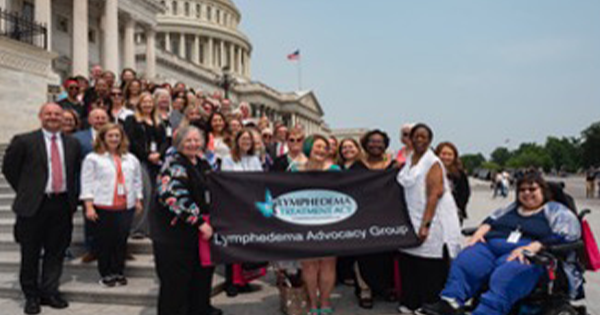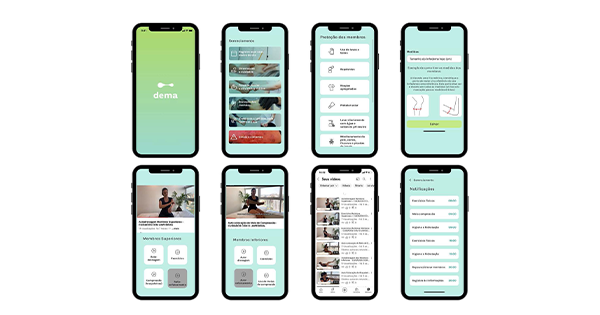The American Lymphedema Framework Project (ALFP) was invited to provide an overview of the status of lymphedema (LE) awareness, treatment, and management in the US over the past 20 years. We invited members of the ALFP steering committee and the leader/founder of the Lymphedema Advocacy Group to respond with perspectives on the advances, as well as concerns, over the past two decades. Following are the voices of an epidemiologist researcher, advocate, clinician/educator and nurse researcher in response to the prompt: “Over the past 20 years in the US I/we have seen changes in the awareness, diagnosis, treatment, and management of lymphedema in the following areas … ”
Dr Electra Paskett, The Ohio State University
Over the last 20 years, our knowledge about what causes lymphoedema and how to treat it has grown enormously.
I have conducted qualitative research to understand the impact of lymphoedema on women’s lives and what providers knew about it. I have also conducted retrospective and cohort studies to estimate the percentage of women who have lymphoedema, as well as associated risk factors. We learned what aetiological factors are predictive of lymphoedema (or increase risk) — infection and obesity among those with axillary node dissection — but the question still remains who should be targeted for prevention measures and what is the optimal intervention that is efficacious and will be used by those at risk? Thus, prevention has still lagged behind.
One notable positive event is that several years ago the National Comprehensive Cancer Network (NCCN) started a lymphoedema subcommittee within its Survivor Committee. This was the first time NCCN had added lymphoedema guidelines to the survivorship guidelines (Denlinger et al, 2018; NCCN Practice Guidelines, 2020).
As part of these guidelines, we added a strong recommendation to refer women with axillary node dissection to physical therapy based on one outcome of an Alliance trial conducted by Dr Armer and myself (Paskett et al, 2021). Women in the intervention group who were referred for physical therapy before symptoms returned to full range of motion sooner, compared to women in the control group.
We recently published a paper presenting the prevalence of lower-extremity lymphoedema in older women and found for the first time that the prevalence in colorectal cancer survivors was similar to that of ovarian cancer survivors (Zhang et al, 2022).
Heather Ferguson, Lymphedema Advocacy Group
One of the most significant changes in the US has been the adoption of widespread health insurance coverage for lymphoedema compression garments, thanks to the Lymphedema Treatment Act (LTA). In late 2009, I met with my federal representative and explained how the lack of coverage for compression garments was affecting my son, who had been born with primary lymphoedema and was just three years old at the time. My congressman agreed to help and, on 23 February 2010, he introduced a bill into Congress addressing the need for this support.
That same year, I founded the Lymphedema Advocacy Group (LAG), and, over the course of nearly 13 years, our group worked tirelessly, leading the effort to increase support for the bill. We established teams of advocates in all 50 states, made thousands of phone calls, sent tens of thousands of emails, and held hundreds of meetings annually with lawmakers and their staff. These efforts culminated in an unheard of 86% of Congress co-sponsoring the bill, making it the most supported piece of healthcare legislation since 2015.
Our work came to fruition when the LTA was passed by Congress on 23 December 2022 (Schakowsky, 2022; Alexander et al, 2024; Figure 2). The new law required that Medicare, our national health plan for seniors and those who are disabled, begin covering these medical supplies on 1 January 2024. It is also required that coverage includes both standard (off-the-shelf) and custom-fit items (Schakowsky, 2022).
Throughout 2023, the LAG worked with the Centers for Medicare and Medicaid Services (CMS) as they wrote the rules for the new coverage to ensure that patients would have access to the items and quantities needed. The coverage allowances include three sets of daytime garments every 6 months, two sets of nighttime garments every 2 years, and no limit on bandaging supplies (Alexander et al, 2024; CMS, 2024; LAG, 2025). Implementation also included the creation of over 70 new codes, to ensure that all parts of the body received equitable coverage.
To be eligible for coverage, patients must have a lymphoedema diagnosis, a prescription for the items, and clinical notes from their doctor, therapist or another treating clinician that support why the specific items are medically necessary (Alexander et al, 2024; CMS, 2024; LAG, 2025). Although these requirements are all standard procedure for any covered medical item, this documentation was not needed in the past if the patient was paying out-of-pocket; therefore, some suppliers and providers are still adjusting to the new protocol.
Although the law could only directly require Medicare to cover these supplies, most other insurance plans eventually follow the precedent set by Medicare. Many other insurance policies have already adopted the new coverage, and our group continues to work on expanding coverage and improving access to care where needed. For additional information, please visit www.LymphedemaAdvocacyGroup.org.
Julia Rodrick, Occupational Therapist
After 40 years as an allied health professional and 27 years in the lymphoedema trenches, I split time between clinical care mentorship and working with an industry stakeholder as senior clinical affairs specialist and research liaison. Throughout my professional journey, I have been privileged to share this space with a diverse group of brilliant, creative, and dedicated people who have generously offered their best efforts to support those who struggle with the potentially debilitating effects of lymphatic, vascular, and oncological disease.
One might say there is a renaissance emerging in lymphoedema care. The strides being made by the scientific community have created technologies that offer a more intimate appreciation for the lymphatic connection to wellness and pathology. The development of creative surgical and pharmaceutical advancements aiming to provide solutions for effective treatment and management is encouraging. There are new modalities developed to enhance the efforts of the lymphoedema specialist with the delivery of manual lymph drainage-like dynamics, and we celebrate the progress made by the industry as compression garments are designed to address the individual needs and lifestyle of our patients (Box 1).
Still, there is reason for concern. As I considered Dr Neil Piller’s invitation to share perspectives on the changes that have occurred in the US over the last 20 years in lymphoedema awareness, education, and treatment, I dug into the ALFP archives, wondering if there might be a position paper that would take me down memory lane and provide a glimpse of the past and a comparison to the present. I found this quote from a meeting report which was published in the Journal of Lymphoedema (Armer et al, 2009).
The current state of affairs undeniably paints an image of a “chaotic patient journey” along the continuum of lymphoedema care, from the time of diagnosis (or misdiagnosis) to identifying and accessing quality treatment, to reimbursement and lifelong continued support and care.
Despite our best efforts, and at the risk of conveying a level of despair, my perspective from the US trenches is that much of the chaos remains. Here are a few observations.
A significant lag in the translation of scientific discovery to clinical (practical) applications impedes timely diagnosis and the trajectory of treatment.
The lack of lymphatic disease education in academia still plagues the medical community. Medical professionals (and health professionals of all disciplines) still struggle to understand, diagnose, and effectively direct lymphoedema treatment.
The current US healthcare system binds therapeutic services (occupational therapy, physical therapy, massage therapy, wound care, home health nursing, medicine, etc) with flat-rate treatment reimbursement. This makes specialised, time-intensive orthopaedics and musculoskeletal rehabilitation that incorporate complete decongestive therapy (CDT) programmes often too costly for viability. A result is the availability of gold standard lymphoedema treatment such as CDT is fading under the oppression of healthcare profit margins.
Out of necessity, industry stakeholders and durable medical equipment (DME) services will eventually dictate the patient care narrative, relying on the interpretations of allowable health care coverage to determine treatment intervention (devices and garments instead of hands-on treatment) with little medical provider oversight or expertise. This trend may lead us backward into a time period without specialised lymphoedema care.
Although the LTA has strengthened the financial support for lymphoedema care, there are interpretation inconsistencies of product coverage among vendors and a great burden has been laid on the referring lymphoedema specialist to provide “proper documentation,” which varies from DME to DME. This makes the assurance of coverage unpredictable.
Surgical interventions are still cost-prohibitive in many cases, due to limitations in insurance coverage.
Successful surgical outcomes are dependent on almost non-existent post-operative protocols. Currently, few research studies validate formal pre- and/or post-operative patient care guidelines, leaving this to the personal choice of the surgeon. This lack of clarity creates anxiety for the patient, compounding care and outcome uncertainty.
The newest trend in the treatment of obesity-induced lymphoedema are the glucagon-like peptide-1 medications. Although these shows great promise, they may at times suffer from inadequate medical oversight, especially in view of the current list of contraindications and side-effects.
Lack of patient adherence continues to influence successful lymphoedema treatment and management. Ostby and Armer (2015) documented suboptimal adherence to the same type of compression devices, garments and general home management protocols we continue to use today. Bar et al (2021) also explored compression therapy adherence in lower extremity lymphoedema, reporting similar adherence rates (12–52%) and adherence barriers. Perhaps the truth of failure lies in industry partners’ willingness to embrace a 20-year-old status quo approach for interventions/modalities and the healthcare community’s willingness to allow it, instead of conveying the expectation of new innovations that will support individualised need and lifestyle at affordable cost. Unfortunately, the trend among the medical community often reverts to patient shaming for nonadherence.
We still have work to be done!
Dr Jane Armer, University of Missouri
Over these past 20 years, we have seen multidisciplinary and multinational research by teams including scientists from nursing, medicine, epidemiology, biostatistics, informatics, physical and occupational therapy, and other stakeholders address issues in reducing risk of and managing lymphoedema across diverse settings and conditions.
The nuances of living with lymphoedema, how symptoms are assessed and managed over the lifetime, and how quality of life is affected and optimised are issues being examined by teams led by nurse scientists like my colleague Dr Elizabeth Anderson and myself (Armer and Stewart, 2005; Fu et al, 2024; Anderson et al, 2025).
We are inviting breast cancer survivors from the landmark NIH-funded study for qualitative interviews focused on living with lymphoedema in the 20+ years of survivorship (Armer and Stewart, 2005). We are now analysing biennial waves of data from the NIH-funded Nurses’ Health Study in which nurse survivors shared their own breast cancer lymphoedema history.
In an example of examining existing large datasets for contributions to understanding risk and outcomes for persons vulnerable to lymphoedema, our team examined outcomes associated with breast cancer, Covid-19, lymphoedema, and fatigue in a national Oracle dataset (Anderson et al, in press).
Multidisciplinary research led by Doubblestein et al (2024) examined current practices by lymphoedema therapists and sought to develop a core patient outcome set to move assessment standardisation forward. Such studies are examples of current research incrementally adding to the body of knowledge in our field and ultimately improving quality of life for persons affected by lymphoedema.
Of recent significance was the second American Cancer Society-Lymphology Association of North America (ACS-LANA) Summit at Washington University in St Louis, Missouri, in 2023. This brought together multidisciplinary lymphoedema experts to assess the current state of lymphoedema management evidence and review certification standards for health professionals caring for this population in the years since the inaugural ACS Summit in 1999 (DiCecco et al, 2024). Facilitated working groups produced seven review articles and six consensus documents, reviewing current literature (Gilchrist et al, 2024) and providing expert recommendations (Stout et al, 2024) spanning the lymphoedema care spectrum.
In conclusion, these four perspectives summarise research, legislative, and clinical strides that have been made in the field of lymphoedema awareness and management in the US over the last 20 years, while highlighting concerns and areas for continued change and improvement. While offering optimism for the future, our reflections remind us that much more remains to be done through research and building evidence-based practice to support people living with lymphoedema. We have a critical opportunity to collaborate with global colleagues to build knowledge and technological capability to advance care for persons living with and at risk for lymphoedema now and in the future.





